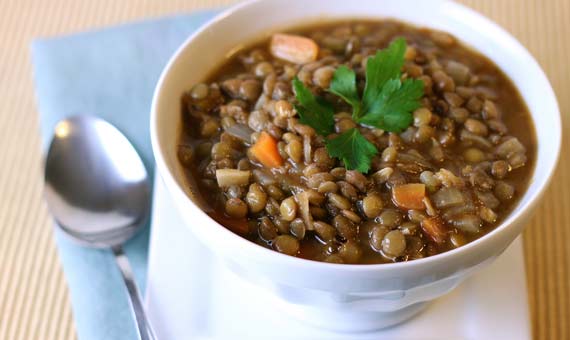Chickpeas, lentils, white and red beans should become one of the human diet’s main sources of protein worldwide. This is the strong message the United Nations (UN) is trying to broadcast to the world by choosing 2016 as the “International Year of Pulses”. For this reason, we overview the main molecules responsible for their healthy, culinary and nutritional properties.

1. More iron than spinach
Although Popeye turned spinach into an extremely famous source of iron, it is a fact that both lentils and white beans contain a higher concentration of this essential mineral. A study published in the Journal of Nutrition revealed the existence of an independent mechanism for the absorption of iron from pulses, and is present in these foods as ferritin. But what is more interesting is that this mechanism is much more effective than the one employed by the digestive system to absorb the iron complex agents of the supplements prescribed until now to treat anaemia. Besides, it does not produce irritation in the intestines. This makes pulses the most effective, safe and healthy natural source of iron.
2. The flavour of pottage
Hexanal and hexanol are the molecules responsible for the unmistakable legume flavour that characterizes traditional pottages. When fresh seeds are crushed or dry seeds are soaked or simmered slowly, the lipoxygenase enzyme is activated when it comes into contact with moisture and oxygen, decomposing the unsaturated fatty acids of pulses in these small aromatic molecules.
3. Healthier sugars
When we start a diet, there is a higher likelihood of us losing weight by having lentils as our source of carbohydrates than by eating white bread. The explanation is simple: the sugars contained in lentils are released slowly (low glycemic index), whereas bread releases a sudden discharge of carbohydrates (high glycemic index) into the blood stream. That is, whether in a Spanish pottage or an Indian dal masoor, lentils provide slow-burning energy.

In addition, if we want to curb our appetite, there is nothing as effective as eating a small serving of cooked pulses. A study published in the journal Obesity estimated that our feeling of hunger is reduced by 31% when we incorporate 160 grams of lentils, chickpeas or beans into our daily diet.
4. Brain anti-aging
The folates contained in pulses reduce the risk of developing Alzheimer’s disease, according to a study conducted by the University of California, Irvine (USA). In fact, everything suggests that these molecules slow down brain aging. A good way to “prevent dementia through food is to combine folates with vitamin E and vitamin B6,” explained Maria M. Corrada, a co-author of the research.
5. Lowering cholesterol
Substituting some of the red meat we regularly consume with pulses can eliminate the excess of bad cholesterol in our bloodstream. More specifically, a study published by the Canadian Medical Association Journal estimated that a cupful of pulses per day (130 grams) reduces low-density lipoprotein (LDL) levels by at least 5 percent. LDL is also popularly known as bad cholesterol. This implies that the risk of heart attacks and strokes also decreases by 5%.
6. Cancer and longevity
It would seem that phenols and flavonoids are the substances that lie behind the ability of white beans to reduce the incidence of breast cancer by nearly 30%, the likelihood of developing colon cancer by 50% and the risk of suffering from prostate cancer also by 50%, according to various studies. The effect is even greater in the case of red and black beans.
Furthermore, thanks to its polyphenol content, the intake of pulses could possibly prolong life. Not surprisingly, it has been demonstrated that a high-polyphenol diet —these molecules can also be found in cocoa, black chocolate, coffee, fruits and vegetables— reduces mortality by 30%, as long as the amount of polyphenols consumed exceeds 650 milligrams per day.
7. Making sure they are well cooked
Why —if red beans are not cooked enough, or if they do not reach boiling poin— can they cause significant digestive distress, including nausea and diarrhea? The cause lies in lecithins, proteins that when well cooked help to protect organs and bacteria from fat accumulation. On the other hand, when lecithins are raw they can be toxic. Ultimately, their role in nature is simply to act as an insecticide and defend plants from possible attacks.
8. Dietary fibers

A resistant type of starch is found in pulses in much larger quantities than in wheat bread grain cereals, as was revealed by a study carried out at the University of Illinois (USA). This starch is not digested and —after passing through the stomach and small intestine undeterred— reaches the colon, where it is fragmented by bacteria, producing butyrate, a byproduct of the digestion of dietary fiber which, according to the latest research, helps prevent cancer.
9. An elephant’s memory
Beans are especially rich in magnesium, another essential mineral. And increasing magnesium intake enhances our memory and learning —both in young and elderly individuals—, according to a study published in the journal Neuron. “Diet can have a significant impact on cognitive ability”, the authors explained, confirming that an extra intake of magnesium stimulates brain cell plasticity, increases the number of synapses and improves the cellular processes needed to store information in our brain cells.
The UN is not dedicating the 2016 International Year of Pulses to all leguminous plant seeds, but in particular to so-called grain legumes (lentils, red beans, white beans, chickpeas …).Therefore, green beans and peas are not included —as they are pod legumes—, nor are the crops belonging to this family which are produced for the extraction of oil, such as soybeans and peanuts. Alfalfa and clover are also excluded.
Comments on this publication